NAUSICAń
OF THE VALLEY OF THE WIND [1984]
Flash
Gordon (Anime Corner
Staff Writer)
Pioneer Elite Plasma Display
System PDP-5050SX
Denon AV Surround Receiver AVR-1801 with Dolby Digital/ DTS
Boston Acoustics Micro90T Die-Cast Surround Speakers including Subwoofer
Toshiba DVD SD-3755 Player with Dolby Digital/ DTS/ 3D Surround Sound.
MOTION PICTURE
PG RATING
B+ ANIMATION
A CHARACTER
A MECH/ OTHER DESIGN
B- MUSIC
A STORY
A- FILM GRADE
STUDIO: TOP CRAFT/ TORU HARA
DIRECTOR: HAYAO MIYAZAKI
PRODUCER: ISAO TAKAHATA
ANIMATOR: KAZUO KOMATSUBARA/ HAYAO MIYAZAKI
DESIGNS: HAYAO MIYAZAKI
SCRIPT: HAYAO MIYAZAKI
MUSIC: JOE HISAISHI
THEME SONG: ĎKAZE NO TANI NO NAUSICAńí HARUOMI HOSONO featuring
NARUMI YASUDA
DVD EXTRAS: BEHIND THE MICROPHONE WITH VOICE TALENT FROM THE FILM: ALISON
LOHMAN, UMA THURMAN, PATRICK STEWART AND EDWARD JAMES OLMOS/ COMPLETE
STORYBOARDS- GET AN INSIDERíS LOOK AT THE FILMíS ARTISTRY/ ORIGINAL
JAPANESE TRAILERS/ THE BIRTH OF STUDIO GHIBLI FEATURETTE
|
| DVD
BREAKDOWN |
OTHER
WORKS BY HAYAO MIYAZAKI |
| REVIEW
(Warning: Spoilers Ahead!) |
Nausicaš Of The
Valley Of The Wind [Kaze No Tani No Nausicaš] [1984] was the milestone that
marked the arrival of director Hayao Miyazaki and Studio Ghibli. The cinematic
achievement germinated from the seeds of Miyazakiís own manga adventure tale
of the same name. His epic labor was the result of over 12 years of sporadic
writing amassing into 59 chapters. The long-running serial blossomed into what
is considered to be his most unforgettable masterpiece. Overflowing with ideas
throughout the process of bringing Nausicaš Of The Valley Of The Wind to life,
an animating studio was sown dubbed Studio Ghibli and flowered with creativity
through Miyazaki and company. ĎGhiblií is Italian for the hot wind that
stretches the arid Sahara. Partners Miyazaki and fellow director Isao Takahata
were looking to make a statement. Their vision: create films of global appeal.
Today, most Studio Ghibli films spread universally like wildfire, or like the
self-described winds across that vast desert land. It seems fitting the studio
should essentially announce its entrance by referring to Ďthe windí of
Miyazakiís first triumphant tour de force.
Studio Ghibliís formation was inevitable. Until that time, Studio Top Craft
[The Hobbit, The Last Unicorn] was the animating group intricately involved in
producing Nausicaš Of The Valley Of The Wind. Upon completion, the studio
closed its 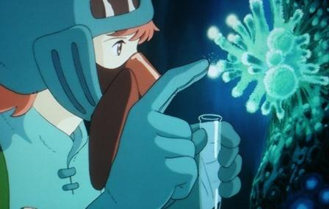 doors.
Studio Top Craft President Toru Hara would become Studio Ghibliís first CEO.
Out of necessity, the fledgling Studio Ghibli became a priority so the talented
animators could move forward on Laputa: Castle In The Sky [1986]. With nowhere
to turn, Takahata [who produced both Nausicaš Of The Valley Of The Wind and
Laputa: Castle In The Sky] ultimately laid the groundwork to get Studio Ghibli
firmly established so together they could influence destiny and make history.
doors.
Studio Top Craft President Toru Hara would become Studio Ghibliís first CEO.
Out of necessity, the fledgling Studio Ghibli became a priority so the talented
animators could move forward on Laputa: Castle In The Sky [1986]. With nowhere
to turn, Takahata [who produced both Nausicaš Of The Valley Of The Wind and
Laputa: Castle In The Sky] ultimately laid the groundwork to get Studio Ghibli
firmly established so together they could influence destiny and make history.
Takahata and Miyazaki collaborated together as far back as Takahataís The
Little Norse Prince Valiant [1968] for Toei Studios. Takahata had directed at
just 27 years of age and Miyazaki was key animator on the film. Soon to follow
was Panda! Go Panda! [1972] directed by Takahata with a screenplay and animation
by Miyazaki. Takahata directed the TV series Anne Of Green Gables [1979] with
scene design and layout by Miyazaki. Their fates were sealed as their lives were
clearly entwined as creators and friends.
Those early formative months for Studio Ghibli started with a phone call from
soon-to-be Studio Ghibli president Toshio Suzuki, then editor of Animage
magazine, to Miyazaki requesting an interview. Suzuki was 29 years of age when
he began work for the magazine in 1978. It was Miyazakiís directorial debut on
the TV series Future Boy Conan [1978], in association with Takahata, and more
importantly as sole director for the film The Castle Of Cagliostro [1979], which
caught Suzukiís attention and lured him to Miyazaki. Legend has it that
Miyazaki ignored 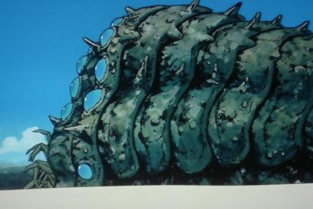 Suzuki
for the better part of his in-person visit. Suzuki was passionate about
Miyazakiís concepts and their bond strengthened as Miyazaki realized
Suzukiís aspirations were genuine. Suzuki was the determined producer, a rare
breed, Miyazaki needed and quickly appreciated. Simultaneously, for a time,
Suzuki was involved in production at the upstart Studio Ghibli while managing
his Animage responsibilities. He was largely accountable for the publication and
serialization of Miyazakiís long-running manga, Nausicaš Of The Valley Of The
Wind, from which the film remains quite faithful. The serial comic debuted in
Animage in 1982 and Animage publisher Tokuma also pressed Miyazaki for a
theatrical rendition of the manga. Juggling both positions became tricky and
Suzuki followed his natural inclination to support the work of Miyazaki and
Takahata whom he supported staunchly through the Animage run. He followed his
heart into the management world of Studio Ghibli leaving the editorial life at
Animage behind. It was Suzuki who fortified the studio vehicle that would become
the voice of Miyazaki and Takahataís creations. The culmination of these
events led to years of the most colorful and fruitful ideas espoused in
animation delighting a planet. The proverbial Ďholy trinityí complete,
Takahata producing, Miyazaki directing and Suzuki promoting, Nausicaš Of The
Valley Of The Wind was their lovechild and to the world it was born.
Suzuki
for the better part of his in-person visit. Suzuki was passionate about
Miyazakiís concepts and their bond strengthened as Miyazaki realized
Suzukiís aspirations were genuine. Suzuki was the determined producer, a rare
breed, Miyazaki needed and quickly appreciated. Simultaneously, for a time,
Suzuki was involved in production at the upstart Studio Ghibli while managing
his Animage responsibilities. He was largely accountable for the publication and
serialization of Miyazakiís long-running manga, Nausicaš Of The Valley Of The
Wind, from which the film remains quite faithful. The serial comic debuted in
Animage in 1982 and Animage publisher Tokuma also pressed Miyazaki for a
theatrical rendition of the manga. Juggling both positions became tricky and
Suzuki followed his natural inclination to support the work of Miyazaki and
Takahata whom he supported staunchly through the Animage run. He followed his
heart into the management world of Studio Ghibli leaving the editorial life at
Animage behind. It was Suzuki who fortified the studio vehicle that would become
the voice of Miyazaki and Takahataís creations. The culmination of these
events led to years of the most colorful and fruitful ideas espoused in
animation delighting a planet. The proverbial Ďholy trinityí complete,
Takahata producing, Miyazaki directing and Suzuki promoting, Nausicaš Of The
Valley Of The Wind was their lovechild and to the world it was born.
Nausicaš Of The Valley Of The Wind is an environmental love letter. It is the
fruit of Miyazakiís blood, sweat and toil that began with the manga. It had to
be a labor of love to bring his  beloved
character to life on the big screen. It is an epic cautionary tale and one of
his absolute best [flanked and complimented only by Princess Mononoke] regarding
man and nature and the fragility of co-existence. Miyazaki set the stage here
regarding his affection for female empowerment and wisdom. His film also marks
the arrival of his voice for the voiceless intent on reaching all who shall
continue to inherit this Earth. It is a parable of woman and nature told within
a highly imaginative science-fiction fantasy. More specifically, it is the story
of a young idealist and her special relationship with a unique breed known as
the Ohmu and how their power could transform a dying world.
beloved
character to life on the big screen. It is an epic cautionary tale and one of
his absolute best [flanked and complimented only by Princess Mononoke] regarding
man and nature and the fragility of co-existence. Miyazaki set the stage here
regarding his affection for female empowerment and wisdom. His film also marks
the arrival of his voice for the voiceless intent on reaching all who shall
continue to inherit this Earth. It is a parable of woman and nature told within
a highly imaginative science-fiction fantasy. More specifically, it is the story
of a young idealist and her special relationship with a unique breed known as
the Ohmu and how their power could transform a dying world.
Enter the story that introduced one of animeís most beloved characters:
Nausicaš Of The Valley Of The Wind. Welcome to future Earth where it has been
ravaged by pollution. This is not the 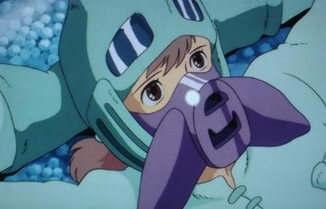 planet
we know. It looks foreign and feels alien. Miyazaki paints a portrait of
warning. Civilization is infected. One thousand years have passed since The
Seven Days Of Fire incinerated the planet. As a result, the proliferation of a
sprawling toxic jungle [referred to as The Sea Of Corruption] threatens to
spread and destroy the remaining human factions. It may arguably be Miyazakiís
darkest hour [next to unnerving Academy Award winner Spirited Away or the
violent Princess Mononoke].
planet
we know. It looks foreign and feels alien. Miyazaki paints a portrait of
warning. Civilization is infected. One thousand years have passed since The
Seven Days Of Fire incinerated the planet. As a result, the proliferation of a
sprawling toxic jungle [referred to as The Sea Of Corruption] threatens to
spread and destroy the remaining human factions. It may arguably be Miyazakiís
darkest hour [next to unnerving Academy Award winner Spirited Away or the
violent Princess Mononoke].
The first images we see and sounds we hear are not the clean, life-affirming
winds of the valley, but the gusting whirr of toxicity twisting echoes of
desolation. Skeletal remains and a lifeless, desperate world are complemented by
the calm, soothing voice of Lord Yupa [eloquently spoken by Patrick Stewart].
ďYet another village is 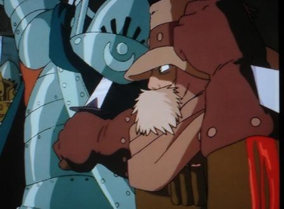 deadÖ
soon this place too will be consumed by the toxic jungleĒ concedes Yupa
cloaked inside vital, breathing apparatus. The establishing shots signal an epic
tale of fantastic, apocalyptic survival, but the encroachment of grim reality
and despair. The mood is very unlike the handful of Miyazaki films that would
follow. Yet, Miyazaki sets the tone for future films by introducing his often
central, courageous female lead. Miyazaki has freely expressed his love for the
female heroine coupled with his sociological and environmental agenda over the
years and Nausicaš is one of his shining, defining character profiles.
deadÖ
soon this place too will be consumed by the toxic jungleĒ concedes Yupa
cloaked inside vital, breathing apparatus. The establishing shots signal an epic
tale of fantastic, apocalyptic survival, but the encroachment of grim reality
and despair. The mood is very unlike the handful of Miyazaki films that would
follow. Yet, Miyazaki sets the tone for future films by introducing his often
central, courageous female lead. Miyazaki has freely expressed his love for the
female heroine coupled with his sociological and environmental agenda over the
years and Nausicaš is one of his shining, defining character profiles.
The groundwork for Nausicaš is the result of character inspiration taken from a
Phaeacian Princess in Homerís The Odyssey coupled with elements of an
insect-charming princess from Japanís  Heian
Period [AD 794-1185]. Together combined with Miyazakiís vision the template
for Nausicaš was cast. Following the brief introduction to the wizened Lord
Yupa, we are graced by the contrasting innocence of Princess Nausicaš who sees
the creatures of the toxic jungle through different eyes. When we meet her she
lays in a field of toxic spores as she gazes skyward into light, willowy poison
flakes. It falls white like snow and despite its lethality she finds beauty in
it [Kikiís Delivery Service [1989] paid homage to Nausicaš with Kikiís own
bright-eyed opening as she lays back to dream in the healthy vibrancy of a
grassy country field reflecting Miyazakiís alternate artistic mood five years
later]. Nausicaš is tender, selfless, brave, deceivingly mighty and skilled, a
truly heroic warrior princess. She lives with her people on a stretch of land
upwind from the infestation of the toxic jungle dubbed The Valley Of The Wind. A
plethora of large windmills dart the picturesque countryside. It is a naturally
shielded location, prosperous and fertile, protected from the deadly spores that
permeate other lands.
Heian
Period [AD 794-1185]. Together combined with Miyazakiís vision the template
for Nausicaš was cast. Following the brief introduction to the wizened Lord
Yupa, we are graced by the contrasting innocence of Princess Nausicaš who sees
the creatures of the toxic jungle through different eyes. When we meet her she
lays in a field of toxic spores as she gazes skyward into light, willowy poison
flakes. It falls white like snow and despite its lethality she finds beauty in
it [Kikiís Delivery Service [1989] paid homage to Nausicaš with Kikiís own
bright-eyed opening as she lays back to dream in the healthy vibrancy of a
grassy country field reflecting Miyazakiís alternate artistic mood five years
later]. Nausicaš is tender, selfless, brave, deceivingly mighty and skilled, a
truly heroic warrior princess. She lives with her people on a stretch of land
upwind from the infestation of the toxic jungle dubbed The Valley Of The Wind. A
plethora of large windmills dart the picturesque countryside. It is a naturally
shielded location, prosperous and fertile, protected from the deadly spores that
permeate other lands.
A vast and dusty wasteland and dead seas separate the valley from the toxic
forests where roam mutant insects of all shapes and sizes. There is no shortage
of them, in particular, the 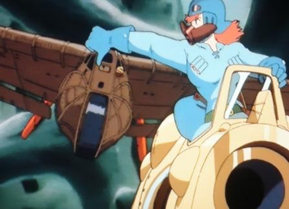 massive,
caterpillar-like crawlers called Ohmu often swarming in herds with a
predisposition for stampeding. The Ohmu are prone to fits of rage when molested
by humans they view as invaders. Nausicaš empathizes and connects with the
creaturesí plight. She knows their pain is misunderstood and utilizes her
special power as a kind of bug whisperer to bridge the communication gap between
their world and ours. When enraged the herds wreak havoc and devastation,
indicated by a change in eye color from blue to red. The ďinsect charmer,Ē
as Lord Yupa refers to Nausicaš, has a special way with all animals illustrated
by her calming influence on a feisty fox squirrel that sharply bites her. She
dissipates itsí fear and befriends what becomes her faithful companion. As for
Lord Yupa, he is a legendary sword master revered across the land as an expert
warrior who also acts as Nausicašís confidant and mentor. Yupaís quest is
to discover a solution to the toxic jungle. The film is filled with rich
secondary characters as weíve come to expect in all Miyazaki pictures, as we
quickly learn Nausicaš and her people are not alone.
massive,
caterpillar-like crawlers called Ohmu often swarming in herds with a
predisposition for stampeding. The Ohmu are prone to fits of rage when molested
by humans they view as invaders. Nausicaš empathizes and connects with the
creaturesí plight. She knows their pain is misunderstood and utilizes her
special power as a kind of bug whisperer to bridge the communication gap between
their world and ours. When enraged the herds wreak havoc and devastation,
indicated by a change in eye color from blue to red. The ďinsect charmer,Ē
as Lord Yupa refers to Nausicaš, has a special way with all animals illustrated
by her calming influence on a feisty fox squirrel that sharply bites her. She
dissipates itsí fear and befriends what becomes her faithful companion. As for
Lord Yupa, he is a legendary sword master revered across the land as an expert
warrior who also acts as Nausicašís confidant and mentor. Yupaís quest is
to discover a solution to the toxic jungle. The film is filled with rich
secondary characters as weíve come to expect in all Miyazaki pictures, as we
quickly learn Nausicaš and her people are not alone.
In a version of Earth increasingly factionalized and segregated [is this really
fiction?], there is a warring; imperialist tribe in the form of the Tolmekian
Empire misguided by the stubborn 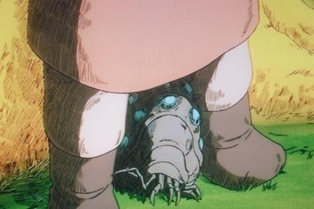 arrogance
and hubris of one Princess Kushana. The Tolmekians are rapidly asserting their
authority across the surviving lands with a dictatorial plan of destroying the
toxic jungle by implementation of scorched earth despite potentially
catastrophic consequences. The people of The Valley Of The Wind are inextricably
absorbed into their plans when a Tolmekian ship crashes inside the valley.
Amidst a fiery blaze, Nausicaš heroically saves Princess Lastelle [in chains],
a prisoner of the Tolmekians abducted from her Pejite homeland. After being
extracted from the flames, Lastelle warns Nausicaš the cargo must be burned
before taking her last living breath. The downed, contaminated Tolmekian craft
has made matters worse by infecting the valley with spores airlifted into the
valley on its hull. They begin infecting the trees and the water.
arrogance
and hubris of one Princess Kushana. The Tolmekians are rapidly asserting their
authority across the surviving lands with a dictatorial plan of destroying the
toxic jungle by implementation of scorched earth despite potentially
catastrophic consequences. The people of The Valley Of The Wind are inextricably
absorbed into their plans when a Tolmekian ship crashes inside the valley.
Amidst a fiery blaze, Nausicaš heroically saves Princess Lastelle [in chains],
a prisoner of the Tolmekians abducted from her Pejite homeland. After being
extracted from the flames, Lastelle warns Nausicaš the cargo must be burned
before taking her last living breath. The downed, contaminated Tolmekian craft
has made matters worse by infecting the valley with spores airlifted into the
valley on its hull. They begin infecting the trees and the water.
Exacerbating the conflict, Princess Kushana has unveiled an embryonic sack
confiscated from Pejite for her own devices. Inside the giant, throbbing cocoon
is one of the last remaining 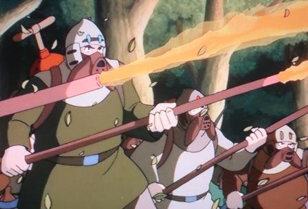 ancient
and powerful warrior gods. These powerful beings once annihilated the planet
then turned to stone. Lord Yupa heard rumor of the unearthing of an ancient
warrior of the old world from Pejite. Itís no longer speculation. It lives, it
thrives and it has been brought inside the unsuspecting valley. The Tolmekians
will stop at nothing to nurture the monster in their suicidal thirst for
domination whilst waging a campaign to eradicate the poison jungle through
warfare as seen fit by Kushana.
ancient
and powerful warrior gods. These powerful beings once annihilated the planet
then turned to stone. Lord Yupa heard rumor of the unearthing of an ancient
warrior of the old world from Pejite. Itís no longer speculation. It lives, it
thrives and it has been brought inside the unsuspecting valley. The Tolmekians
will stop at nothing to nurture the monster in their suicidal thirst for
domination whilst waging a campaign to eradicate the poison jungle through
warfare as seen fit by Kushana.
The king, Nausicašís father, is overrun by Tolmekians. Nausicaš is overcome
with fury at the site of her fatherís murder by the invaders. She ferociously
thrusts upon them lashing out, like a 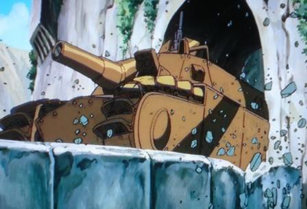 feral
animal, blinded by rabid vengeance. Her irrational reaction, out of step with
her character, is an understandably pure, basic, gut reaction and one which
mirrors the response of the Ohmu when threatened; creatures with whom she shares
a natural empathy and connection. We easily submit to the emotional response and
motivations of Nausicaš and the Ohmu based on the fundamentals of animal
behavior. At last, Lord Yupa intervenes and Nausicaš calms her blood thirst.
Nausicaš, like the Ohmu, regains her composure and implores her people to lay
down their arms. She pleads wishing no more death or bloodshed upon her people.
Nausicaš knows war is not the answer. The Tolmekians urge the valley peoples to
join them in resurrecting the warrior god as they relent. Princess Kushana makes
clear her intention to use the creature to cleanse the Earth of the toxic
jungle. The village elder warns such foolhardy actions will only end in
destruction for all. Soon, the Tolmekians begin subjugating the people of the
valley, removing their arms and enslaving them, but never breaking their will.
feral
animal, blinded by rabid vengeance. Her irrational reaction, out of step with
her character, is an understandably pure, basic, gut reaction and one which
mirrors the response of the Ohmu when threatened; creatures with whom she shares
a natural empathy and connection. We easily submit to the emotional response and
motivations of Nausicaš and the Ohmu based on the fundamentals of animal
behavior. At last, Lord Yupa intervenes and Nausicaš calms her blood thirst.
Nausicaš, like the Ohmu, regains her composure and implores her people to lay
down their arms. She pleads wishing no more death or bloodshed upon her people.
Nausicaš knows war is not the answer. The Tolmekians urge the valley peoples to
join them in resurrecting the warrior god as they relent. Princess Kushana makes
clear her intention to use the creature to cleanse the Earth of the toxic
jungle. The village elder warns such foolhardy actions will only end in
destruction for all. Soon, the Tolmekians begin subjugating the people of the
valley, removing their arms and enslaving them, but never breaking their will.
Later, Lord Yupa finds Nausicaš has absconded to a secret place, a garden
greenhouse deep underground through a concealed passageway inside the castle
walls. He is startled to find 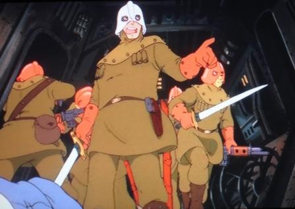 her
shrine of plants [those found in the toxic jungle] are alive and well, healthy
and unaffected by the same toxins that plague the jungle. He inhales breathable
air and is witness to her refuge. Nausicaš has discovered the truth and shares
her knowledge. Her place is irrigated with fresh soil and clean running water.
Outside of the valley, it is the soil that is poisoned. The flora is not the
source of the devastation.
her
shrine of plants [those found in the toxic jungle] are alive and well, healthy
and unaffected by the same toxins that plague the jungle. He inhales breathable
air and is witness to her refuge. Nausicaš has discovered the truth and shares
her knowledge. Her place is irrigated with fresh soil and clean running water.
Outside of the valley, it is the soil that is poisoned. The flora is not the
source of the devastation.
Back above, Nausicaš agrees to leave with some of the Tolmekians for Pejite.
Whilst among the pillow-like cumulous clouds, the airship is attacked by a
Pejite gunship. Engulfed in flames, she 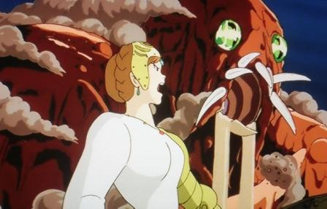 boards
her own gunship inside the Tolmekian craftís bay and escapes with Mito and
Princess Kushana. Distracted by the sudden site of Princess Nausicaš, the
Pejite pilot is shot down into the Sea Of Corruption. Nausicaš and company land
in the waters below kept afloat by the buoyant aircraft. The Ohmu greet Nausicaš,
but will not harm her. An intriguing flashback sequence from her childhood
reveals clues to her special connection with the Ohmu. The creatures inform
Nausicaš the Pejite pilot is alive and she quickly exits upon her personal
glider housed within her gunship and flees the hostile Kushana. Kushana is
brought back to the valley by Mito.
boards
her own gunship inside the Tolmekian craftís bay and escapes with Mito and
Princess Kushana. Distracted by the sudden site of Princess Nausicaš, the
Pejite pilot is shot down into the Sea Of Corruption. Nausicaš and company land
in the waters below kept afloat by the buoyant aircraft. The Ohmu greet Nausicaš,
but will not harm her. An intriguing flashback sequence from her childhood
reveals clues to her special connection with the Ohmu. The creatures inform
Nausicaš the Pejite pilot is alive and she quickly exits upon her personal
glider housed within her gunship and flees the hostile Kushana. Kushana is
brought back to the valley by Mito.
Nausicaš rescues Asbel, the Pejite pilot, from certain death at the hands of
the jungleís creeping critters. He is the brother of Princess Lastelle.
Nausicaš and Asbel fall deep beneath the toxic forest into a kind of pristine
cavity where they discover life has renewed and the air and waters run pure. The
sea has evolved and the trees are now filtering the poisons left by the ills of
mankind. Asbel and Nausicaš repair the downed glider and return to Pejite.
Pejite is littered with the dead. Mangled bodies and bug corpses blanket the
burning land. His people inform Asbel they plan to re-take the giant warrior
using whatever means necessary including wiping out The Valley Of The Wind. By
luring the insects to the valley everyone will die. Incensed, Asbel holds his
people at gunpoint and tells Nausicaš to escape and warn her people, but Asbel
is knocked unconscious. Nausicaš attempts to enlighten the Pejite with the good
news surrounding the jungleís evolution. She pleads with them proclaiming the
trees have purified the water, while the Ohmu are merely acting as sentinels to
the land. She urges calm, but cooler heads do not prevail and she is taken
captive as the Pejite take flight toward the valley. Miyazaki implements
Princess Lastelleís mother as the life-affirming force of reason that frees
Nausicaš so she may escape into the skies upon her glider in the hopes of
saving her people.
In The Valley Of The Wind, Nausicašís people initiate an uprising, commandeer
a tank and weapons and begin fighting back against the warmongering Tolmekians.
The battle ends in a stalemate as the valley peoples hold up inside an old,
impregnable, metallic shipwreck along the seashore utilizing it as a makeshift
fortress.
Nausicaš races against time in the hopes of staving off certain disaster
between the Tolmekians and her people in a deteriorating standoff. Her peaceful
people battered proclaim with dignity, ďWe prefer the ways of the water and
the windĒ [the clear voice of Miyazaki]. As Nausicaš fast approaches she
spots a stampeding Ohmu herd and is horrified by what incites their wrath. The
Pejite have harpooned and brutally bloodied a baby Ohmu dangling it before the
storming Ohmu mass as bait to fuel their fury and drive them toward the valley.
Mito arrives on the battlefield to warn everyone that Nausicaš, the proverbial
herald, is coming to halt the impending onslaught. Despite the warning, Kushana
awakens the giant 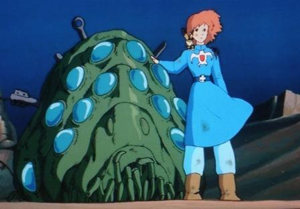 warrior
prematurely unleashing the malformed behemoth. Dressed in a red Pejite dress,
Nausicaš startles the Pejite pilots and brings the Ohmu baby down. Nausicaš is
shot and wounded in the process. She weeps over the baby Ohmu riddled with
shrapnel. She is pained by its suffering and heartless treatment discarding her
own injuries. The baby motions to crawl into the toxic waters, but Nausicaš
braces herself between the creature and the sea while acid singes her feet.
Digging into the sand she pushes it back to safety. The Ohmu baby ceases its
drive and connects with Nausicašís love. The undaunted Nausicaš stands
steadfast in her charge to bring peace and prevent the mass slaughter of her
people and the Ohmu. Still, the Ohmu throng presses onward through Nausicaš and
the baby with bloodlust.
warrior
prematurely unleashing the malformed behemoth. Dressed in a red Pejite dress,
Nausicaš startles the Pejite pilots and brings the Ohmu baby down. Nausicaš is
shot and wounded in the process. She weeps over the baby Ohmu riddled with
shrapnel. She is pained by its suffering and heartless treatment discarding her
own injuries. The baby motions to crawl into the toxic waters, but Nausicaš
braces herself between the creature and the sea while acid singes her feet.
Digging into the sand she pushes it back to safety. The Ohmu baby ceases its
drive and connects with Nausicašís love. The undaunted Nausicaš stands
steadfast in her charge to bring peace and prevent the mass slaughter of her
people and the Ohmu. Still, the Ohmu throng presses onward through Nausicaš and
the baby with bloodlust.
On the hilltop the warrior giant emerges dripping with deformity. Despite its
weakened condition it projects a lethal beam of oral firepower laying waste to
the incoming Ohmu. Inevitably its shape dissolves into a soupy, primordial
puddle. Nausicaš miraculously calms the Ohmu pursuit, which has surrounded the
baby. Bright red eyes subside and give way to the serenity of tranquil blue. The
horde of Ohmu lifts a lifeless Nausicaš toward the heavens with their
tentacle-like feelers. The creatures pay an almost religious tribute to their
beloved savior who stood before them willing to die. Revived, her multi-legged
friends restore life. Her dress alters from red to blue [actually saturated with
the baby Ohmuís blood] accenting the changing emotional tide.
The ancient writings foretold of a male hero who would come forth and renew
life, but the answer to the prophecy was instead a young woman named Nausicaš
Of The Valley Of The Wind. She 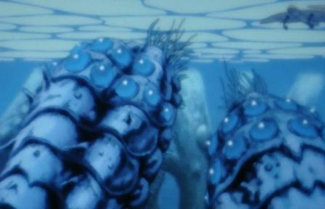 is
symbolic of Miyazakiís female ideal and would represent the gold standard for
films to come. She is a selfless herald, the culmination of nurture and nature.
Miyazaki illustrates this with a final shot of her blue cap beside a green
seedling sprouting from the barren sands. Only through the nurturing touch of a
woman combined with natureís resilience will the planet survive. And so
Miyazakiís tale comes full circle, ending on a note of hope embodied by two
key images that contrast to the filmís opening shots of skeletonized death.
is
symbolic of Miyazakiís female ideal and would represent the gold standard for
films to come. She is a selfless herald, the culmination of nurture and nature.
Miyazaki illustrates this with a final shot of her blue cap beside a green
seedling sprouting from the barren sands. Only through the nurturing touch of a
woman combined with natureís resilience will the planet survive. And so
Miyazakiís tale comes full circle, ending on a note of hope embodied by two
key images that contrast to the filmís opening shots of skeletonized death.
Nausicaš Of The Valley Of The Wind is a brilliant action adventure that is
filled with the kind of heart and eco-friendly social conscience only Miyazaki
could pen. So what the hell were US distributors thinking in 1995? It was
originally released in the US as Warriors Of The Wind [1995], disgracefully and
heavily edited, de-Miyazaki-d if you will. The director and company were
justifiably mortified and ensured that a Ďno edití clause was amended to all
future licensing deals. This measure secured the proper treatment of all Studio
Ghibli releases since, via Disney Buena Vista. All studio productions are issued
unedited in their entirety as the creators intended them to be experienced.
Nausicaš Of The Valley Of The Wind rightfully received the grand treatment and
a second chance.
As a result of Studio Ghibliís unofficial formation talent soon followed. The
animation is a marvel to behold even more astonishing when considering how old
the film is. It has its shortcomings and from time to time frames do lose detail
or backdrops get simplified, while some scenes are fantastic in their minutiae.
For example, Nausicašís underground greenhouse is a breathtaking sequence.
The scene is more arresting than a good portion of anime produced today.
Character designs are exquisite, Nausicaš in particular. Her stylish blue
uniform is striking and still holds its own decades later. Her blue skirt and
kinky boots stand the test of time. I mean, those boots are made for walking. As
fans of the manga might have hoped, watching the screen is like witnessing the
heart and soul of Hayao Miyazaki come to life. Mechanical designs are simple but
inventively retro from Nausicašís personal glider and flying gunship to the
hulking, early steampunk-styled, metallic warships. Creature designs are
astounding. Nausicašís feisty fox squirrel companion is a clever 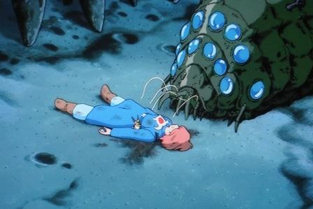 critter
design. The mighty herds of caterpillar-like Ohmu with giant saucer-shaped red
and blue eyes are unforgettable. Finally, the brief appearance of the fearsome
warrior god is a classic. In fact itís not surprising, the giant warrior
designs, explosions and deeply imaginative heavy tank mecha came compliments of
fledgling animator/ designer Hideaki Anno as a key animator. Yes, the future
genius behind Neon Genesis Evangelion. Anno does with a disintegrating monster
in the filmís conclusion what some could only hope to achieve with their
design work over the course of an entire production series. Weaponry is ultra
retro chic including Nausicašís modernized rifle complete with gunpowder to
the Tolmekiansí medieval-like battle armor. Mattes provided for the toxic
jungle are soft in blue and grey coloration emphasizing an environment ravaged
by the pollution and poisoning of mankind. The subdued colors enhance and
illustrate Miyazakiís message of a dying world. The classic look of the
spore-infested jungle is suggestive of cover art from a 1970s fantasy novel. On
the whole, cel animation is colorful and awe-inspiring where life is thriving.
Additionally, other techniques were utilized including Ďcut paperí methods
for presenting the large Ohmu herds. This was part of the improvisational aspect
of animation in the day without access to computer technology and CGI
enhancements so readily available today. Due to lower cel counts, at times, it
lacks the fluidity of later Studio Ghibli works, but for a picture circa 1984 it
is remarkably painstaking in its artistry. Finer details are evident in later
studio productions, but this film is raw and heartfelt in its loving execution.
Miyazaki is a master of mise en scŤne creating those distinct worlds in all of
his pictures. The art of Nausicaš Of The Valley Of The Wind established the
studioís reputation and the bar has been raised ever since.
critter
design. The mighty herds of caterpillar-like Ohmu with giant saucer-shaped red
and blue eyes are unforgettable. Finally, the brief appearance of the fearsome
warrior god is a classic. In fact itís not surprising, the giant warrior
designs, explosions and deeply imaginative heavy tank mecha came compliments of
fledgling animator/ designer Hideaki Anno as a key animator. Yes, the future
genius behind Neon Genesis Evangelion. Anno does with a disintegrating monster
in the filmís conclusion what some could only hope to achieve with their
design work over the course of an entire production series. Weaponry is ultra
retro chic including Nausicašís modernized rifle complete with gunpowder to
the Tolmekiansí medieval-like battle armor. Mattes provided for the toxic
jungle are soft in blue and grey coloration emphasizing an environment ravaged
by the pollution and poisoning of mankind. The subdued colors enhance and
illustrate Miyazakiís message of a dying world. The classic look of the
spore-infested jungle is suggestive of cover art from a 1970s fantasy novel. On
the whole, cel animation is colorful and awe-inspiring where life is thriving.
Additionally, other techniques were utilized including Ďcut paperí methods
for presenting the large Ohmu herds. This was part of the improvisational aspect
of animation in the day without access to computer technology and CGI
enhancements so readily available today. Due to lower cel counts, at times, it
lacks the fluidity of later Studio Ghibli works, but for a picture circa 1984 it
is remarkably painstaking in its artistry. Finer details are evident in later
studio productions, but this film is raw and heartfelt in its loving execution.
Miyazaki is a master of mise en scŤne creating those distinct worlds in all of
his pictures. The art of Nausicaš Of The Valley Of The Wind established the
studioís reputation and the bar has been raised ever since.
Composer Joe Hisaishi provides the score. The sweeping, beautiful opening music
is trademark Hisaishi that Miyazaki would come to rely upon for years to come.
Despite highlights, some of the compositions have not fared well over the years,
unlike his later soundtrack work. Time has not been kind to this production
thanks to a slight over reliance on vintage early-80s era synthesizers. Those
dated electronic bpms [beats per minute] have a tendency to date the material.
Some numbers lack the sophistication of his orchestral, string-driven suites
that would flourish in his repertoire later. A few cheesy keyboard moments
aside, the songs are good, just flawed in comparison to later Hisaishi/ Miyazaki
collaborations.
Buena Vista, the distribution arm of Walt Disney, provides yet another sterling
Studio Ghibli remastering. Walt Disney has even enlisted a stellar cast of voice
talent for the creation of the English dub in Alison Lohman, Uma Thurman, Mark
Hamill, Edward James Olmos and the always, brilliant vocal presence of the
commanding Patrick Stewart. His dignified delivery is ideal for Lord Yupa as he
easily lip syncs behind a wavering moustache and facial bush. The DVDís Behind
The Microphone segment is delightful as always. Itís a regular feature, albeit
brief, on the dubbing process for these Studio Ghibli releases and they are a
joy to watch.
Studio Ghibli was official in 1985. Laputa: Castle In The Sky [1986] would
follow and was the first official release by the upstart company as a studio.
Still it was Nausicaš Of The Valley Of The Wind that became the inspiration for
the legacy of Studio Ghibli. There is clearly an elegiac and mournful tone to
Miyazakiís message represented by the emotional pain and struggle of its
characters here, but it concludes in a climactic styled crescendo. The pace
eases closing on a hopeful note regarding the harmony of man with nature even
beyond apocalypse. It is one of two epic environmental powerhouse films from the
mind of Miyazaki urging harmony as essential to survival [kindred spirit
Ashitaka is the spiritual brother to Nausicaš in the equally astounding
Princess Mononoke]. Miyazakiís desire to salvage the natural world is embodied
through Nausicaš in her fight for the Ohmu. Nausicaš is a traditionally heroic
female leader and one Miyazaki has reincarnated for decades. She, like so many
of his characters, is fiercely independent, maturing, seeking enlightenment and
deeply sympathetic, a mold cast by Miyazaki for years to come. Nausicaš Of The
Valley Of The Wind is a rare, definitively original science-fiction/ fantasy.
This defining, sweeping cinema would fortify the relationships of three wise,
visionary men [Miyazaki/ Takahata/ Suzuki] for generations, elevating anime and
animation to new heights, undiscovered frontiers and giving life to characters
like none the world has ever seen. Come and reap the wild wind of Miyazaki and
company.
CHARACTERS:
NAUSICAń
LORD YUPA
KUSHANA
KUROTOWA
ASBEL
MITO
PEJITE MAYOR
OHMU

